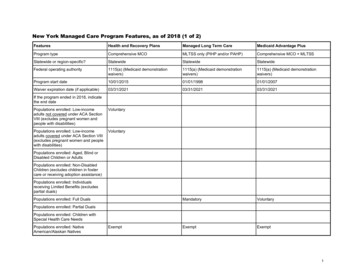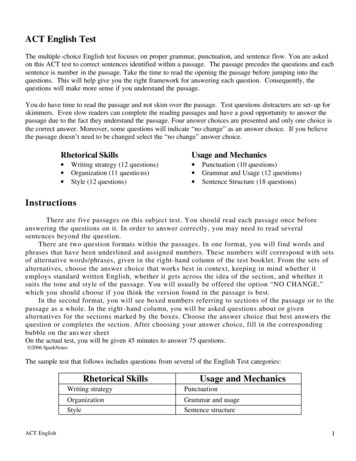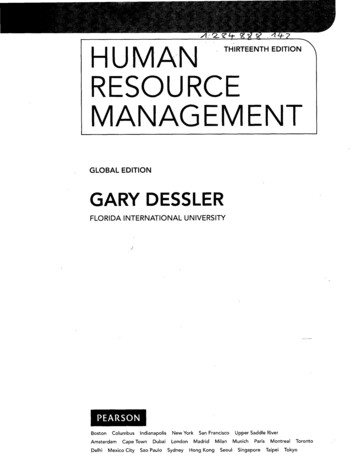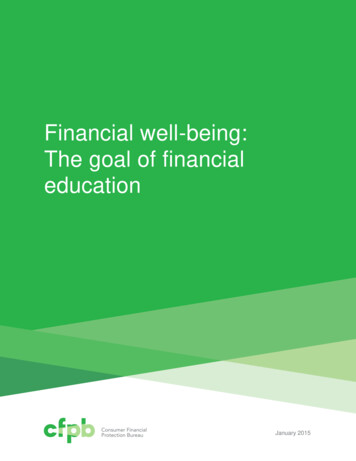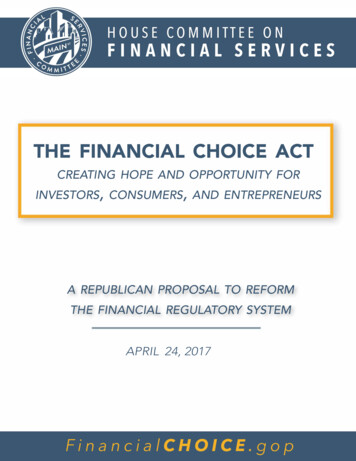
Transcription
THE FINANCIAL CHOICE ACTCREATING HOPE AND OPPORTUNITY FORINVESTORS, CONSUMERS, AND ENTREPRENEURSA REPUBLICAN PROPOSAL TO REFORMTHE FINANCIAL REGULATORY SYSTEMAPRIL 24, 2017FinancialCHOICE.gop
OutlineThe Dodd-Frank Off-Ramp for Strongly Capitalized, Well-Managed BankingOrganizationsBankruptcy Not BailoutsRepeal of the Financial Stability Oversight Council’s SIFI Designation AuthorityReform the Consumer Financial Protection BureauRelief from Regulatory Burden for Community Financial InstitutionsFederal Reserve ReformUpholding Article I: Reining in the Administrative StateAmend Dodd-Frank Title IVRepeal the Volcker RuleRepeal the Durbin AmendmentEliminate the Office of Financial ResearchSEC Enforcement IssuesReforms to Title IX of Dodd-FrankCapital FormationRepeal Specialized Public Company Disclosures for Conflict Minerals, ExtractiveIndustries, and Mine SafetyImproving Insurance Regulation by Reforming Dodd-Frank Title V2The Financial CHOICE ActApril 24, 2017
The Dodd-Frank Off-Ramp for Strongly Capitalized, WellManaged Banking OrganizationsExecutive Summary: Excessive regulatory complexity – embodied by the Dodd-Frank Act, the Baselcapital accords, and other post-crisis regulatory initiatives – produces a lessresilient financial system, cements the competitive advantages enjoyed by “toobig to fail” firms, and harms economic growth. Dodd-Frank’s particular brand of regulatory complexity and government micromanagement has made basic financial services less accessible to small businessesand lower-income Americans, and saddled America’s small and medium-sizedcommunity financial institutions with a crushing regulatory burden. The Financial CHOICE Act enhances U.S. financial market resiliency and promoteseconomic growth by offering well-managed, well-capitalized financial institutions– those with a simple leverage ratio of 10 percent – an “off ramp” from DoddFrank’s suffocating regulatory complexity.The Problem: Excessive Regulatory Complexityand Anemic Economic GrowthIn the years following the financial crisis of 2008, the size and scope of financial regulationsmushroomed, as politicians in the U.S. and around the world rushed to put new rules inplace, despite the absence of any evidence that it was a lack of regulatory tools – asopposed to regulatory incompetence and misguided government housing policies – thatprecipitated the crisis. 1As the dust begins to settle on the post-crisis response, however, there has been a growingrecognition that financial regulation has become far too complex and too intrusive andplaces too much faith in the discretion and wisdom of bank regulators. In 2012, AndrewHaldane, Chief Economist of the Bank of England, gave a speech at a Federal Reserveconference in Jackson Hole, Wyoming, that has achieved notoriety among financialregulators and scholars. After observing that “no regulator had the foresight to predict the1See Patrick McLaughlin and Robert Greene, Did Deregulation Cause the Financial Crisis? Examining a CommonJustification for Dodd-Frank, MERCATUS CENTER, GEORGE MASON UNIVERSITY (Jul. 19, 2013), available r-dodd-frank/(“Deregulation of the financial services sector in the years leading up to the 2008 crisis was—and still is—used tojustify Dodd-Frank’s substantial regulatory burdens. But financial regulation did not decrease in the decade leadingup to the financial crisis—it increased Regulatory restrictions in Title 12 of the Code of Financial Regulation—which regulates banking—increased by 18.2 percent while the number of restrictions in Title 17—which regulatescommodity futures and securities markets—increased by 17.4 percent.”).3 The Financial CHOICE ActApril 24, 2017
financial crisis, although some have since exhibited supernatural powers of hindsight,”Haldane delivered a warning to his regulatory brethren:Modern finance is complex, perhaps too complex. Regulation of modernfinance is complex, almost certainly too complex. That configuration spellstrouble. As you do not fight fire with fire, you do not fight complexity withcomplexity. Because complexity generates uncertainty, not risk, it requires aregulatory response grounded in simplicity, not complexity. Delivering thatwould require an about-turn from the regulatory community from the pathfollowed for the better part of the past 50 years. 2For Haldane, “Exhibit A” in the trend toward excessive regulatory complexity was what hereferred to as “the Tower of Basel,” the global risk-based capital regime that, as discussedin more detail below, played a central role in triggering – and prolonging – the recentfinancial crisis. But perhaps the ultimate monument to regulatory complexity andbureaucratic hubris is the Dodd-Frank Act, 3 2,300 pages of legislative text that have to datespawned more than 22,000 pages of new federal regulations, or the equivalent of “roughly15 copies of ‘War and Peace.’” 4The Democrats who drafted Dodd-Frank claimed that their reforms were narrowlytargeted at the “too big to fail” institutions that were at the center of the crisis. But bylayering mind-numbing amounts of complexity onto an already labyrinthine regulatoryedifice, Dodd-Frank played into the hands of the largest banks, at the expense of Americanhouseholds and small- and medium-sized community financial institutions. Instead ofending “too big to fail,” Dodd-Frank created “too small to succeed.” 52Andrew Haldane, Chief Economist and the Executive Director of Monetary Analysis and Statistics at the Bank ofEngland, Address at the Federal Reserve Bank of Kansas City’s 366th economic policy symposium: The dog and theFrisbee (Aug. 31, 2012), (hereinafter Andrew Haldane, The dog and the Frisbee) available athttp://www.bis.org/review/r120905a.pdf. See also John Kay, Complexity, not size, is the real danger in banking,FINANCIAL TIMES, (Apr. 12, 2016), available at 2733f755.(“As the size of the Dodd-Frank legislation shows, we have locked ourselves into a spiral in which regulatorycomplexity gives rise to further organizational complexity and the construction of yet more esoteric instruments.”).3See generally Dodd-Frank Wall Street Reform and Consumer Protection Act, Pub. L. No. 111-203, 124 Stat. 13762223 (2010) (hereinafter Dodd-Frank Act).4Kirsten Grind and Emily Glazer, “Inside Enforcers Shake Up Bank Culture,” WALL STREET JOURNAL, (May 31,2016) (calling Dodd-Frank “one of the most complex pieces of legislation ever”). In the words of Andrew Haldanein his “Dog and the Frisbee” speech, “once completed Dodd-Frank could comprise 30,000 pages of rulemaking.That is roughly a thousand times larger than its closest legislative cousin, Glass-Steagall. Dodd-Frank makes GlassSteagall look like throat-clearing.” See Patrick McLaughlin & Oliver Sherhouse, The Dodd-Frank Wall StreetReform and Consumer Protection Act May Be the Biggest Law Ever,” MERCATUS CENTER, GEORGE MASONUNIVERSITY, (Jul. 20, 2015), available at aw-ever/. (The scale of the rule-writing required by Dodd-Frank “vastly exceedsany previous regulation of financial markets, and dwarfs the regulations that accompanied all other legislationenacted during the Obama administration.”)5See Michael Rapoport, “Small Banks Look to Sell as Rules Bite,” Wall Street Journal, April 2, 2014 (quoting DanBaird of Capital Funding Group); Preston Ash et al., “Too Small to Succeed? – Community Banks in a NewRegulatory Environment” (Federal Reserve Bank of Dallas, Financial Insights, Vol. 4, Dec. 2015),https://www.dallasfed.org/ /media/documents/outreach/fi/2015/fi1504.pdf4 The Financial CHOICE ActApril 24, 2017
Indeed, the biggest Wall Street firms are the beneficiaries (not the victims) of Dodd-Frank,both because the law cements their status as “too big to fail” and because the massiveregulatory dragnet it casts over the financial system confers an advantage on firms with thesize and scale to absorb the complex new regulatory mandates. Goldman Sachs CEO LloydBlankfein has stated publicly that his firm “will be among the biggest beneficiaries ofreform,” 6 telling an investor conference in February 2015:More intense regulatory and technology requirements have raised thebarriers to entry higher than at any other time in modern history. This is anexpensive business to be in, if you don't have the market share in scale.Consider the numerous business exits that have been announced by ourpeers as they reassessed their competitive position and relative returns. 7JP Morgan Chase CEO Jamie Dimon has referred to the post-crisis regulatory regime ascreating a “bigger moat” that protects his bank and other “too big to fail” firms fromcompetition by new entrants and small firms that cannot so easily digest the costs of theDodd-Frank regulatory requirements. 8 In 2015 testimony before the Oversight andInvestigations Subcommittee, securities law expert and former University of Virginia LawSchool Dean Paul Mahoney rendered the following verdict: “Dodd-Frank is designed insignificant part to enhance the regulatory reach of bank regulators. Inevitably, that willmean increasing the size, market share, and political clout of the largest banks.” 9To make matters worse, banking system consolidation and crushing compliance costscaused by Dodd-Frank and Basel are not offset by tangible benefits to financial stability oraccess to consumer credit. Instead, excessive regulatory complexity has made the U.S.financial system less accessible and more dangerous.The sheer weight, volume, and complexity of regulation for community financialinstitutions affects their ability to provide the products and services necessary to allowsmall businesses to grow and consumers to access credit to realize their financial andpersonal goals.Today’s “too small to succeed” regulatory paradigm results indemonstrable economic harm on Main Street.According to a 2015 study by researchers at Harvard University’s Kennedy School ofGovernment entitled “The State and Fate of Community Banking,” the “increasingly6Joe Weisenthal, Lloyd Blankfein: We Will Be Among the Biggest Beneficiaries of Financial Reform, BUSINESSINSIDER, (May 5, 2010), available at -reform-2010-5.7Regulation is Good for Goldman, WALL STREET JOURNAL, (Feb. 11, 2015), (citing comments made by Mr.Blankfein at an investor conference), available at -goldman1423700859.8Joe Weisenthal, The 4 Things That Worry Jamie Dimon , BUSINESS INSIDER, (Feb. 4, 2013), (citing interview byCitigroup analyst Keith Horowitz), available at t-worry-jamiedimon-2013-29The Dodd-Frank Act and Regulatory Overreach: Hearing Before the Subcomm. on Oversight and Investigations,H. Comm. on Fin. Services, 114th Cong. 1st Sess. (May 13, 2015) (statement of Professor Paul G. Mahoney),available at hrg-114-ba09-wstate-pmahoney-20150513.pdf.5 The Financial CHOICE ActApril 24, 2017
complex and uncoordinated regulatory system [embodied by Dodd-Frank] has created anuneven regulatory playing field that is accelerating consolidation [among communityfinancial institutions] for the wrong reasons.” The study described a post-crisiscompetitive landscape characterized by “community banks’ declining market share inseveral key lending markets, their decline in small business lending volume, and thedisproportionate losses being realized by particularly small community banks.” 10The “regulatory taxes” imposed by Dodd-Frank are passed along to the customer in theform of increased fees or more limited credit and product availability. Dodd-Frank policies– particularly those stemming from the Bureau of Consumer Financial Protection’s topdown regulatory approach – have contributed to an array of regressive trends in access tocredit for American households, including the following: 10Low-income Americans in need of basic consumer credit products find theseproducts increasingly less available. 11The availability of basic banking services has shrunk drastically since Dodd-Frank(for example, the share of banks offering free checking accounts fell from 75 percentpre-Dodd-Frank to 38 percent in 2016). 12Banking fees have risen (for example, monthly service fees rose 111 percentbetween the enactment of Dodd-Frank and 2014). 13According to an FDIC study released in 2016, 7 percent of households in the UnitedStates were unbanked in 2015, representing approximately 9 million householdsMarshall Lux & Robert Greene, The State and Fate of Community Banking, Harvard Kennedy School ofGovernment (Feb. 2015) (hereinafter Lux & Greene, The State and Fate of Community Banking), available tions/awp/awp37. Other research details the toll that Dodd-Frankis taking on small community financial institutions. See, e.g., Preston Ash et al., supra note 4; Ken B. Cyree, “TheDirect Costs of Bank Compliance around Crisis-Based Regulation for Small and Community Banks” (WorkingPaper, Presented at the Federal Reserve Bank of St. Louis, Third Annual Community Banking Research and PolicyConference, Sep. 30 - Oct. 2015), 3 Paper3 Cyree.pdf;Hester Peirce et al., “How Are Small Banks Faring under Dodd-Frank?” (The Mercatus Center at George MasonUniversity, Working Paper No. 14-05, Feb. ce SmallBankSurvey v1.pdf.11See generally Marshall Lux & Robert Greene, Out of Reach: Regressive Trends in Credit Card Access (MossavarRahmani Center for Business & Government Associate Working Paper No. 54, John F. Kennedy School ofGovernment, Harvard University, Apr. 2016) (hereinafter “Lux and Greene, Out of Reach: Regressive Trends inCredit Card Access”), ions/awp/awp54.12See 2016 Bankrate checking account survey: ATM fees stay on record-setting streak, BANKRATE, available cordsetting-streak/; Todd Zywicki, Opinion, Geoffrey Manne, & Julian Morris, How to Help the Unbanked? Repeal TheDurbin Amendment, FORBES CAPITAL FLOWS (Aug. 4, 2014), available t/#43b6d8605a5f.13Lux and Greene, Out of Reach: Regressive Trends in Credit Card Access, at 20.6 The Financial CHOICE ActApril 24, 2017
(disproportionately low-income Americans). 14 An additional 19.9 percent of U.S.households, or 24.5 million households, were underbanked. 15There are 50 million fewer credit cards accounts today than 2008. Between 2009 and2012, about 30% of lower-credit borrowers (12 million people) lost access to creditcards completely, and those options that remain cost more than they did before. Thoseoptions that remain cost more, with credit card interest rates 325 basis points higherfor borrowers with higher FICO scores and 360 basis points higher for borrowers withlower scores. 16An April 2015 study by economists at Goldman Sachs reached a similar conclusion aboutthe “pass-through” effects of post-crisis banking regulations on small businesses that relyheavily on the community banking sector for their funding:The tax from increased bank regulation falls disproportionately on thesmaller businesses that have few alternative sources of finance. We see thisin the muted recovery in bank lending to small businesses: outstandingcommercial and industrial (C&I) loans for less than 1 million are still wellbelow the peak 2008 level and are only 10% above the trough seen in 2012.In contrast, larger C&I loans outstanding (above 1 million) are more than25% higher than the peak in 2008. Moreover, the cost of the smallest C&Iloans has risen by at least 10% from the pre-crisis average. The evidencesuggests that smaller firms continue to borrow from banks – when they canget credit – because they lack effective alternative sources of finance. It alsosuggests that they are paying notably more for credit today; this weighs ontheir ability to compete with larger firms and to create new jobs. 17Unsurprisingly but unfortunately, Dodd-Frank has placed credit out of reach for manysmall businesses. Overall, bank small business loans have declined 11 percent since DoddFrank was enacted, in large part due to regulatory burdens on community banks. Sixtythree percent of microbusinesses and 58 percent of start-ups report unmet financingneeds, according to a recent survey published by the Atlanta Fed. 18 The result is stifledAmerican entrepreneurship and a less robust Main Street economy.14BOARD OF GOVERNORS OF THE FEDERAL RESERVE SYSTEM, REPORT ON THE ECONOMIC WELL-BEING OF U.S.HOUSEHOLDS IN 2014 (May 2015).152015 FDIC National Survey of Unbanked and Underbanked Households (October 20, 2016).16GOLDMAN SACHS GLOBAL MARKETS INSTITUTE, THE TWO-SPEED ECONOMY 13 (2015), available two-speedeconomy.17Id. at 12.18FEDERAL RESERVE BANKS OF NEW YORK, ATLANTA, BOSTON, CLEVELAND, PHILADELPHIA, RICHMOND, & ST.LOUIS, SMALL BUSINESS CREDIT SURVEY: REPORT ON EMPLOYER FIRMS, (Mar. 2016), available ss/survey/2015/report-on-employer-firms.aspx?panel 1.7 The Financial CHOICE ActApril 24, 2017
The Solution: A New Paradigm Offering Well-Capitalized, Well-Managed FinancialInstitutions Relief from Excessive Regulatory ComplexityAs the enormous costs and economic harm from the Dodd-Frank Act and other post-crisisregulatory initiatives have come into sharper relief, a consensus has begun to emerge thatthere has to be a better approach to financial regulation, one that prizes simplicity overneedless complexity, and market discipline over regulatory arbitrage and central planning.A good description of this alternative approach was offered recently by former FederalReserve Board Governor Robert Heller:A healthy financial sector needs a light, but firm regulatory and supervisoryhand, with as few rules as possible. A few simple rules, including a strongcapital base, are more important than micromanagement of the banks by theregulators. Complex regulations lead to huge compliance departments thatjust add a dead-weight bureaucracy to the financial system. Better to investin higher capital levels that present a true and reliable cushion againstadverse circumstances. Ever more complex regulations and a myriad ofregulators and overlapping regulatory jurisdictions do not make the financialsystem more safe and sound. 19In an era where agreement on financial regulatory matters is hard to come by, support for aregulatory model in which banks operate at higher capital levels in exchange for relief fromgovernment micro-management is surprisingly broad-based. 20For those who view the Dodd-Frank Act as an alarming expansion of an unaccountable anduncontrollable administrative state, the appeal of such a trade-off is obvious. It shiftspower away from Washington, and holds the promise of reversing the distorted incentivesof a system in which taxpayers, rather than shareholders, creditors and management, aremade to pay the costs when a “too big to fail” bank collapses. 2119ROBERT HELLER, THE UNLIKELY GOVERNOR: AN AMERICAN IMMIGRANT’S JOURNEY FROM WARTIME GERMANYTO THE FEDERAL RESERVE BOARD 231 (Maybridge Press, 2015).20See Alan Greenspan, More capital is a less painful way to fix the banks, FINANCIAL TIMES, (Aug. 17, 2015),available at af2f4d6e0e5eda22.html?siteedition intl#axzz410gZ8sNQ, (“Lawmakers and reg
Apr 24, 2017 · The Financial CHOICE Act enhances U.S. financial market resiliency and promotes . places too much faith in the discretion and wisdom of bank regulators. In 2012, Andrew Haldane, Chief Economist of the Bank of England, gave a speech at a Federal Reserve . form of increased fees or more limited


